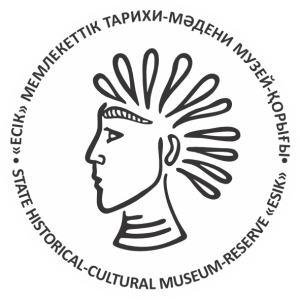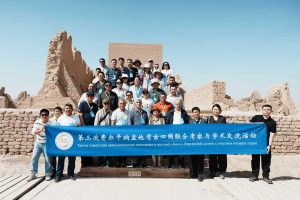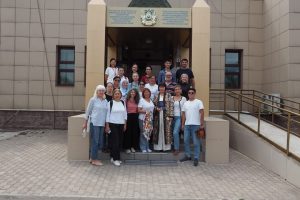Information letter
Dear colleagues!
“Esik” State Historical and Cultural Reserve-Museum (Esik Town, Kazakhstan) invites you to participate in the International scientific and practical online conference “III Esik Readings” on the topic of “The Written Monuments of Central Asia (The Challenges of Translation and Interpretation)”, which will take place on November 22, 2022.
Topics to be discussed:
– Ancient writings: myth, sign, and symbol;
– Writing as a symbol in art and culture (archaeological, ethnological, cultural studies, art studies);
– Brief archaeological reports (results of archaeological excavations).
Working languages of the conference: Kazakh, Russian, and English.
A mixed form of participation:
1. Participation in the conference as a speaker (offline);
2. Participation in the conference as a speaker (in video conference mode online);
3. Participation as an article author in the collection of conference materials.
A collection of articles is planned to be published as a result of the conference.
Requirements for participation in the conference:
To participate in the conference, you need to fill out the application at the end of this letter and send it to the e-mail address esikoqulary@gmail.com by November 1, 2022.
Please fill out the application completely.
Reports and articles in Kazakh and Russian languages should be sent by November 12, 2022. Papers and articles in English should be submitted by November 10.
The applicants will receive a notification about the status of their applications by November 15, 2022. If the report is found suitable for participation in the conference, the order and program of the conference, a link to join the conference will be sent to a participant.
Additional information could be obtained from the conference organizers: Dosym Zikiriya +7(727) 306-91-30, +7 707 7537878, Hamit Aitkul +7 701 3503645
The editorial board asks the authors to follow the following rules when preparing articles.
1. Volume from 5 to 10 pages, paper size A4; only in doc and rtf format, using MS Word editor.
2. The size of the font is 14 pt Times New Roman (cyr), line spacing – 1.15. Borders on all sides 2 cm, width-justify, indentation 1.2 cm, portrait orientation, automatic line-end hyphenation, text style “regular”.
3. Placing the text on the front page:
1 line – the title of your work (CAPITALS, aligned in middle, semi-bold font);
2 line – empty;
3 line – author(s) last name, first name, patronymic, aligned in e middle;
Line 4 – institution, city (if it is included in the name of the institution, the city is not indicated). Correction in the middle;
Next, after one interval, is the text of the article (justify adjusted).
4. Abstract (200-250 words) and keywords (5-7 words) in Kazakh, Russian and English languages. An abstract is a summary of the content of a scientific work, giving a general idea of its topic and structure. If the text of the report is in the Kazakh language, then it should have abstracts in Russian and English languages. If the text of the report is in Russian, then the abstracts should be in Kazakh and English. If the main text is in English, then the abstract must be provided in Kazakh and Russian languages.
Keywords should include the most complete disclosure of the content of the article. For each specific material, please, provide 5-6 keywords; the most important keywords should be the first in the list. When adding keywords to your proposed article, please keep in mind that many modern information systems carry out contextual search only by titles and references of scientific publications.
5. It is better to limit yourself to generally accepted abbreviations and not to introduce new abbreviations if there is no sufficient reason for it. It is better to explain the meaning of the introduced abbreviations.
6. There should be consistence when marking symbols and signs in tables, figures, formulas. Images should be clear and sharp. Figures and tables in the text should all have references. All figures and tables must have titles. Abbreviations of words, names and titles are not allowed, except for commonly used abbreviations for physical, chemical, technical, and mathematical measuring units.
Image materials must be provided in the following formats: for photos, images – tiff or jpeg (300 dpi for black and white and color); tables, diagrams, drawings, etc. in – exls, cdr. The author’s last name, the name of the article and the number of the picture must be indicated on the back of the picture or below it. Images should be placed according to the text, and additionally must be submitted as separate files (they will be used later during the layout design works). The picture titles given in a separate list at the end of the article. All authors sign the manuscript at the end of the article
7. There must be a mandatory list of literature (from 10 to 20 sources) with the sources used, drawn up according to GOST. The bibliography list is given only in square brackets without quotation [12], when quoting or narrating the author’s text [12, p. 29]. References in the article text are numbered according to the numbers given in the bibliography at the end of the article. Archival materials are not included in the list, their references are placed in round brackets in the text. When the article uses sources from electronic resources or Internet, the bibliographic record of the source and the full Internet address of the source are cited in the bibliography. It is better to indicate the time when this source was accessed.
Examples of bibliographic description:
For books: Authors’ surnames and initials. Title. – Place of publication: Printing house, year of publication. – the number of pages.
For example:
1. Akishev A.K. Art and mythology of the Saka People. – Alma-Ata: Nauka, 1984. – 176 p.
For journal articles: Authors’ surnames and initials. Name of the article. // Title of the publication. (Series). – Year of publication. – Volume. – Number. – Pages.
For example:
2. Akishev A.K. Ideology of Saka People from Semirechya (based on the materials of the Issyk Mound) // Early nomads. / KSIA. Issue 154. M.: – 1978. – pages 39-48.
Conference materials, collections of works, etc.: Authors’ surnames and initials. Name of the article. // Title of the publication. Type of publication. – Place of publication, year. – Volume. – Number. – Pages.
For example:
3. Aitkul H.A., Mukhtarova G.R., Zheleznyakov B.A., Koszhanova A.M. Some issues related to the Bronze Age of Zhetysu // ІІ Esik readings International scientific-practical online conference on the theme “Emergence and development of statehood in the Eurasian steppe belt: prerequisites, stages, consequences” dedicated to the 30th anniversary of the Independence of the Republic of Kazakhstan. – Esik, 2021. – pages. 136-144.
For electronic sources:
Tsypilova S. S. Women in medieval Mongolia: a brief historical overview // Humanitarian vector. 2018. No. 6. URL: https://cyberleninka.ru/article/n/zhenschina-v-srednevekovoy-mongolii-kratkiy-istoricheskiy-obzor (viewed on: 08/05/2022).
8. Information about the authors
For the electronic version: please indicate surname, first name, patronymic; scientific degree; scientific title; main workplace; home, work or mobile phones; e-mail and postal address (for contacting the editors), information about each author; name of the organization, city, country where the work was done, e-mail of one of the authors should be indicated. Authors’ place of work should be cited.
It is necessary to indicate: faculty (Scientific research university, department), university, city, country. Departments, sections, and other subdivisions should not be indicated.
The author has the right to submit several works for publication.
Authors in other cities will be sent an electronic version of the collection.
An electronic version of the article should be submitted to the editors in accordance with the requirements. The file name must start with the first author’s last name in Latin (for example, Aitkul. doc(in rtf)). The pages of the article must be numbered. All articles submitted to the editorial office must be peer-reviewed. If necessary, the article may be returned to the author for correction. The editor reserves the right to make changes to the text that do not alter the meaning of the article.
The text of the article, the name of the file should be changed to the author’s last name, first name, patronymic (initials). If the author has more than one article, it should be numbered in the file names (“Last name, A.А-1 doc”, “Last name, A.А-2 doc”, etc.). The style and formatting of the template should be preserved, the text is provided in either Kazakh, Russian and English languages.
Information about the conference will be updated on the website: https://issykrm.kz/
If you have any questions, please contact the conference organizing committee of the “Esik” State Historical and Cultural Museum-Reserve by phone numbers:
+7(727) 306-91-30,
+7(701) 350-36-45,
e-mail: esikoqulary@gmail.com
An article formatting example
UDC
ARTICLE TITLE
Zhumai G.A.1, e-mail address Aitpek B.I.2, e-mail address
1 State historical and cultural museum-reserve “Esik” Yesik, Kazakhstan.
2 Institute of Archaeology. A.H. Margulana, g. Almaty, Kazakhstan.
Abstract (200-250 words).
Keywords (5-7).
Article text Article text Article text Article text Article text Article text Article text Article text Article text Article text Article text Article text Article text Article text Article text Article text Article text Article text Article text Article text article text article text.
Bibliography with used sources:
Should be given in numbered alphabethic order. See examples above.
Information about the authors:
- Zhumai G.A., “Esik” State historical and cultural museum-reserve, scientific degree, title, e-mail address, contact phone number, Esik city, Kazakhstan.
- Aitpek B.I. Institute of Archeology named after A.H. Margulan, position, scientific degree, scientific title, e-mail address, contact phone number, Almaty, Kazakhstan.
APPLICATION
For participation in the online conference “The Written Monuments of Central Asia (Challenges of Translation and Interpretation)”.
| Last Name/First Name/Patronymic | |
| Position, academic degree, title | |
| Organization | |
| Address | |
| Country | |
| Phone number | |
| Fax | |
| Title of the article or paper | |
| Type of Participation (in person/online/paper) | |
| Panel name | |
| Additional information |



